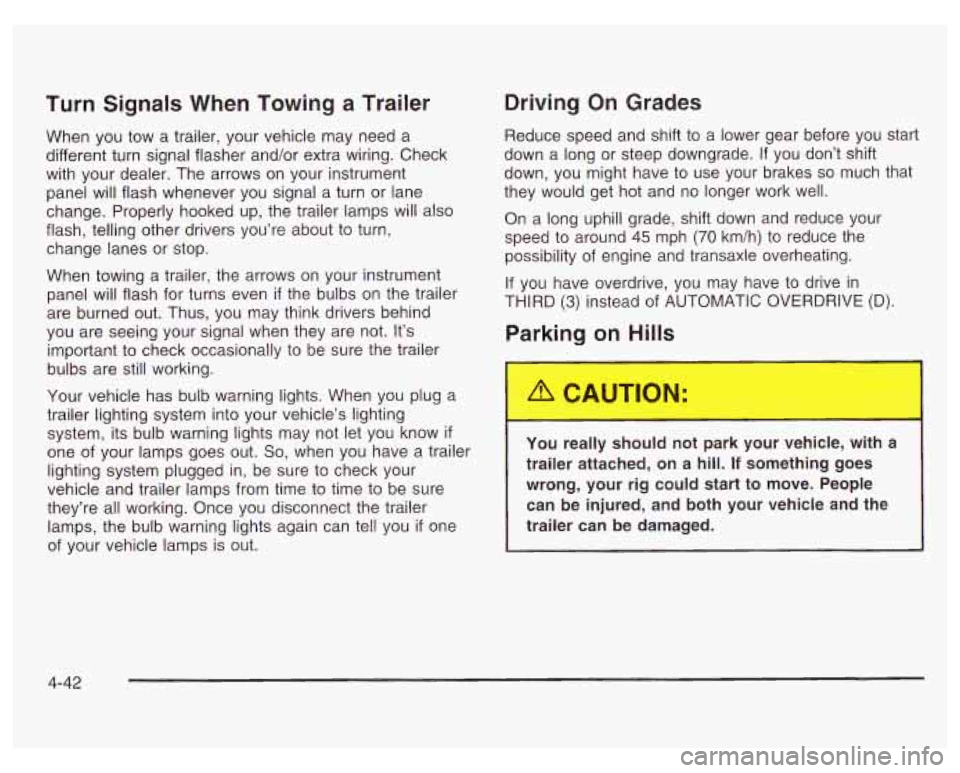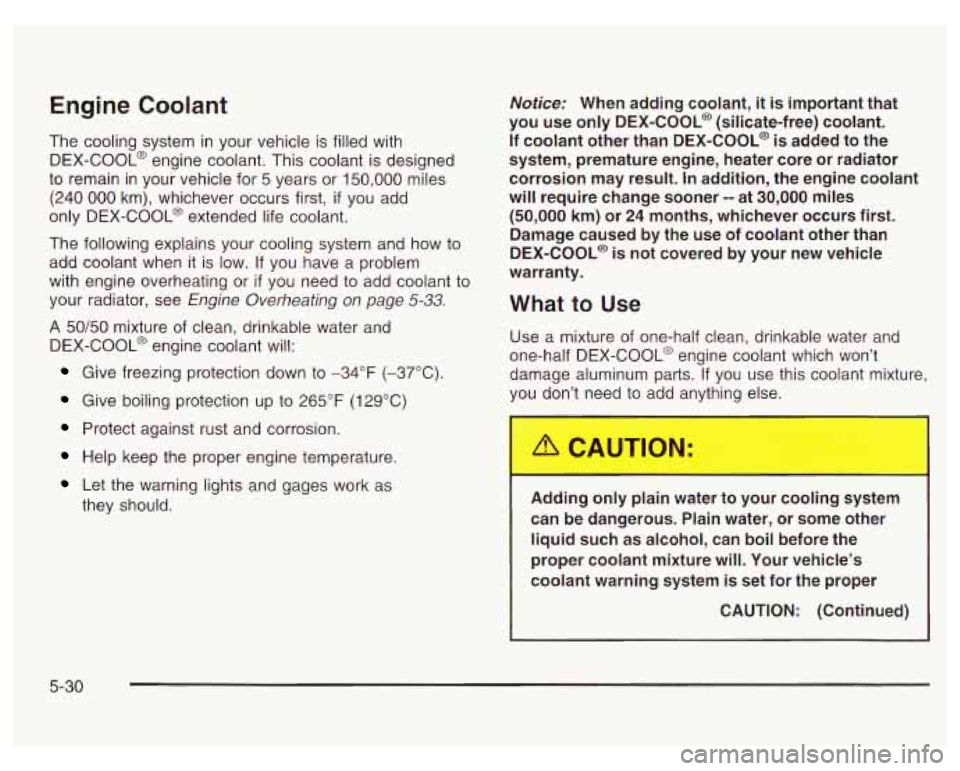2003 PONTIAC GRAND PRIX warning lights
[x] Cancel search: warning lightsPage 160 of 378

The Driver Information Center (DIC) gives you important
safety and maintenance facts. When you turn the
ignition on, all of the DIC lights illuminate for a few
seconds. After this, the DIC will begin working.
Functions
__ (Door Ajar): If one of the doors is ajar, this light
will appear next to that door on the vehicle outline.
CHANGE OIL SOON: This light will appear when the
system indicates that it’s time for an oil change. The
system predicts remaining oil life using data from length
of drives, coolant temperature, engine rpm and
vehicle speed. It alerts you to change the oil on a
schedule consistent with the vehicle’s driving conditions.
After changing the oil, the system must be reset. See
How to Reset the GM
Oil Life SystemTM under
Engine
Oil on page 5- 18.
e LOW: This light will come on when the ignition is
on and the fluid in the washer fluid container is low.
AJAR: This light alerts you that the trunk is not
fully closed.
LOW TRAC (Low Traction): If your vehicle is equipped
with anti-lock brakes, this light will come on when the
enhanced traction system is limiting wheel spin. See Enhanced Traction System (ETS) on page 4-
I I or
Low Traction Light on page 3-30.
TRAC OFF (Traction Off): If your vehicle is equipped
with anti-lock brakes, this light lets you know that
the enhanced traction system has been disabled and
will not limit wheel spin. See Enhanced Traction System
Warning Light
on page 3-30 or Low Traction Light on
page 3-30.
TRAC (Traction): If the vehicle has anti-lock brakes
and the enhanced traction system, you will have a
disable button on the far right side of the DIC.
The enhanced traction system is automatically activated
when you turn the ignition on. This button will
activate/deactivate the system. If you need to disable
the system, such
as when you are stuck and are rocking
the vehicle back and forth, push this button. See If
You Are Stuck: in Sand, Mud, Ice or Snow on
page 4-32.
3-39
Page 223 of 378

Turn Signals When Towing a Trailer
When you tow a trailer, your vehicle may need a
different turn signal flasher and/or extra wiring. Check
with your dealer. The arrows on your instrument
panel will flash whenever you signal a turn or lane
change. Properly hooked up, the trailer lamps will also
flash, telling other drivers you’re about to turn,
change lanes or stop.
When towing a trailer, the arrows on your instrument
panel will flash for turns even
if the bulbs on the trailer
are burned out. Thus, you may think drivers behind
you are seeing your signal when they are not. It’s
important to check occasionally to be sure the trailer
bulbs are still working.
Your vehicle has bulb warning lights. When you plug a
trailer lighting system into your vehicle’s lighting
system, its bulb warning lights may not let you know
if
one of your lamps goes out. So, when you have a trailer
lighting system plugged in, be sure to check your
vehicle and trailer lamps from time to time to be sure
they’re all working. Once you disconnect the trailer
lamps, the bulb warning lights again can tell you
if one
of your vehicle lamps is out.
Driving On Grades
Reduce speed and shift to a lower gear before you start
down a long or steep downgrade.
If you don’t shift
down, you might have to use your brakes
so much that
they would get hot and no longer work well.
On a long uphill grade, shift down and reduce your
speed to around
45 mph (70 km/h) to reduce the
possibility of engine and transaxle overheating.
If you have overdrive, you may have to drive in
THIRD (3) instead of AUTOMATIC OVERDRIVE (D).
Parking on Hills
1 -J really should not ,,rk yo^, wG,kle, with a
trailer attached, on a hill.
If something goes
wrong, your rig could start to move. People
can be injured, and both your vehicle and the
trailer can be damaged.
4-42
Page 255 of 378

Engine Coolant
The cooling system in your vehicle is filled with
DEX-COOL@ engine coolant. This coolant is designed
to remain in your vehicle for
5 years or 150,000 miles
(240
000 km), whichever occurs first, if you add
only DEX-COOL@ extended life coolant.
The following explains your cooling system and how to
add coolant when it is low.
If you have a problem
with engine overheating or
if you need to add coolant to
your radiator, see Engine Overheating on page
5-33.
A 50/50 mixture of clean, drinkable water and
DEX-COOL@ engine coolant will:
Give freezing protection down to -34°F (-37°C).
Give boiling protection up to 265°F (129°C)
Protect against rust and corrosion.
Help keep the proper engine temperature.
Let the warning lights and gages work as
they should.
Notice: When adding coolant, it is important that
you use only
DEX-COOL@ (silicate-free) coolant.
If coolant other than DEX-COOL@ is added to the
system, premature engine, heater core or radiator
corrosion may result. In addition, the engine coolant
will require change sooner
-- at 30,000 miles
(50,000 km) or 24 months, whichever occurs first.
Damage caused by the use
of coolant other than
DEX-COOL@ is not covered by your new vehicle
warranty.
What to Use
Use a mixture of one-half clean, drinkable water and
one-half DEX-COOL@ engine coolant which won’t
damage aluminum parts. If you use this coolant mixture,
you don’t need to add anything else.
1 ---.-.g only p n water to your c 3 system
can be dangerous. Plain water, or some other
liquid such as alcohol, can boil before the
proper coolant mixture will. Your vehicle’s
coolant warning system is set
for the proper
CAUTION: (Continued)
I
5-30
Page 374 of 378

Vehicle Identification
Number (VIN)
............................................. 5-96
Service Parts Identification Label
................... 5-96
Vehicle Personalization .................................... 2-43
Arming and Disarming the Content
Theft-Deterrent System
............................. 2-52
Automatic Door Locks
.................................. 2-45
Content Theft-Deterrent System
..................... 2-51
Delayed Illumination and Exit Lighting
............. 2-44
Entering Programming Mode
......................... 2-44
Exiting Programming Mode
........................... 2-53
Last Door Closed Locking and Lockout
Protection
............................................... 2-47
Remote Driver Unlock Control
....................... 2-48
Remote Lock and Unlock Confirmation
........... 2-49
Vehicle Storage
.............................................. 5-53
Ventilation Adjustment
...................................... 3-22
Vinyl
............................................................. 5-90
Visor Vanity Mirror
.......................................... 2-14
Visors
.............................. .............. 2-14
Warning Lights. Gages and Indicators
................ 3-23
Hazard Warning Flashers
............................... 3-3
Other Warning Devices
.................................. 3-4
Warnings Warnings
(cont.)
...
Safety and Symbols ......................................... III
Vehicle Damage .............................................. iv
Washing Your Vehicle
...................................... 5-91
Weatherstrip Lubrication ................................... 6-10
Weight of the Trailer
........................................ 4-38
Weight of the Trailer Tongue
............................. 4-39
What Kind of Engine
Oil to Use ........................ 5-20
What Kind of
Oil to Use .................................. 5-24
What to Do with Used Oil
................................ 5-24
What to Use
.................................. 5-30, 5-47, 5-48
Wheels Alignment and Tire Balance
.......................... 5-73
When to Add Engine Oil
.................................. 5-19
When to Change Engine Oil
(GM Oil Life SystemTM) ................................ 5-23
When to Check
...................................... 5-24, 5-69
When to Check and Change
............................ 5-27
When to Check Power Steering Fluid
................ 5-47
When You Are Ready to Leave After
Parking on a Hill
......................................... 4-43
Where to Put the Restraint
............................... 1-38
Window Lock-Out
............................................ 2-14
Windows
....................................................... 2-13
Power
........................................................ 2-14
Windshield and Wiper Blades
....................... 5-92
Replacement
............................................... 5-73
Why Safety Belts Work
..................................... 1-8
15